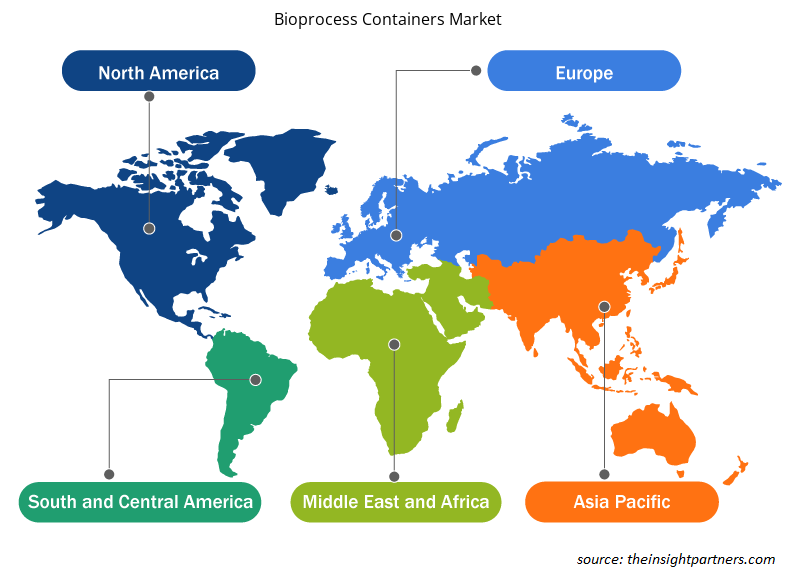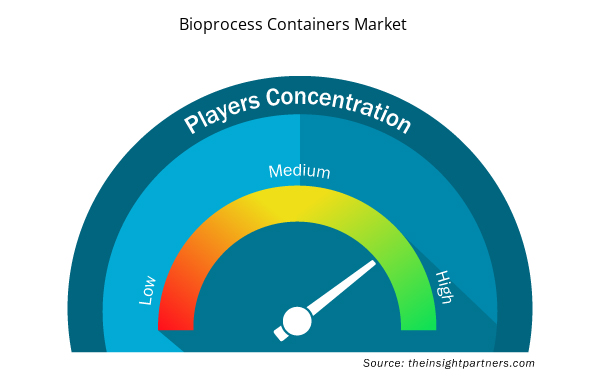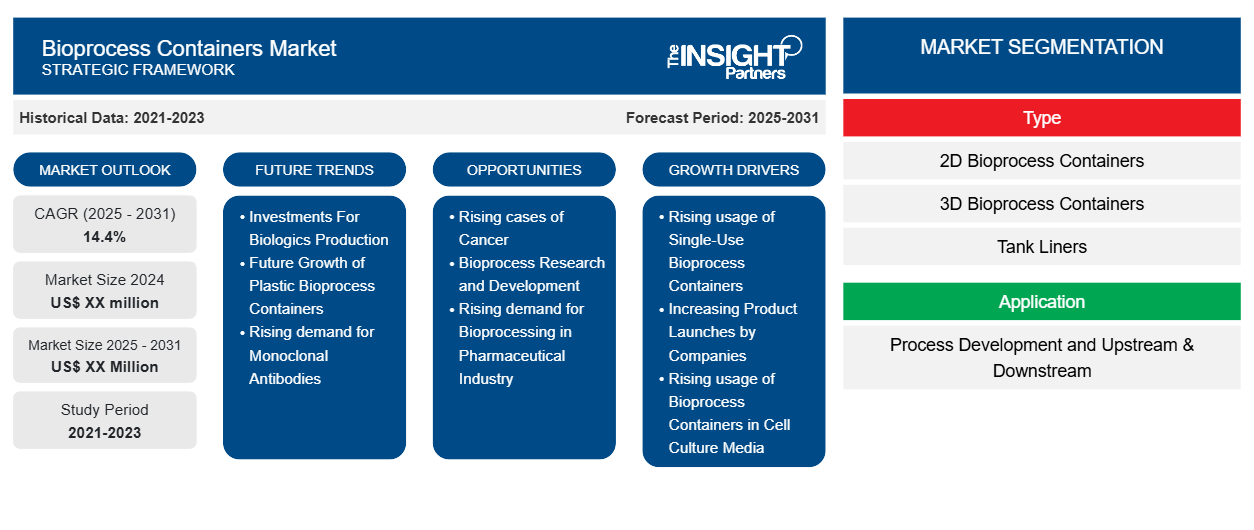Der Markt für Bioprozessbehälter wird voraussichtlich von 2023 bis 2031 eine durchschnittliche jährliche Wachstumsrate (CAGR) von 14,4 % verzeichnen, wobei die Marktgröße von XX Millionen US-Dollar im Jahr 2023 auf XX Millionen US-Dollar im Jahr 2031 wachsen wird.
Der Bericht ist segmentiert nach Markt für Bioprozessbehälter nach Typ (2D-Bioprozessbehälter, 3D-Bioprozessbehälter, Tankauskleidungen und andere), Anwendung (Prozessentwicklung und Upstream & Downstream), Endnutzer (Biopharmazie- und Biowissenschafts- und F&E-Unternehmen) und Geografie (Nordamerika, Europa, Asien-Pazifik, Naher Osten und Afrika sowie Süd- und Mittelamerika). Die globale Analyse ist weiter auf regionaler Ebene und nach wichtigen Ländern aufgeschlüsselt. Der Bericht bietet den Wert in USD für die oben genannte Analyse und Segmente.
Zweck des Berichts
Der Bericht „Markt für Bioprozessbehälter“ von The Insight Partners soll die aktuelle Situation und das zukünftige Wachstum sowie die wichtigsten treibenden Faktoren, Herausforderungen und Chancen beschreiben. Dies wird verschiedenen Geschäftspartnern Einblicke geben, wie zum Beispiel:
- Technologieanbieter/-hersteller: Um die sich entwickelnde Marktdynamik zu verstehen und die potenziellen Wachstumschancen zu kennen, damit sie fundierte strategische Entscheidungen treffen können.
- Investoren: Durchführung einer umfassenden Trendanalyse hinsichtlich der Marktwachstumsrate, der finanziellen Marktprognosen und der Chancen entlang der Wertschöpfungskette.
- Regulierungsbehörden: Zur Regulierung von Richtlinien und Überwachungsaktivitäten auf dem Markt mit dem Ziel, Missbrauch zu minimieren, das Vertrauen der Anleger zu bewahren und die Integrität und Stabilität des Marktes aufrechtzuerhalten.
Marktsegmentierung für Bioprozessbehälter
Typ
- 2D-Bioprozessbehälter
- 3D-Bioprozessbehälter
- Tankauskleidungen
- Andere
Anwendung
- Prozessentwicklung und Upstream & Downstream
Endbenutzer
- Biopharmazeutische und Life-Science-Unternehmen sowie F&E-Unternehmen
Geographie
- Nordamerika
- Europa
- Asien-Pazifik
- Süd- und Mittelamerika
- Naher Osten und Afrika
Geographie
- Nordamerika
- Europa
- Asien-Pazifik
- Süd- und Mittelamerika
- Naher Osten und Afrika
Passen Sie diesen Bericht Ihren Anforderungen an
Sie erhalten kostenlos individuelle Anpassungen an jedem Bericht, einschließlich Teilen dieses Berichts oder einer Analyse auf Länderebene, eines Excel-Datenpakets sowie tolle Angebote und Rabatte für Start-ups und Universitäten.
- Holen Sie sich die wichtigsten Markttrends aus diesem Bericht.Dieses KOSTENLOSE Beispiel umfasst eine Datenanalyse von Markttrends bis hin zu Schätzungen und Prognosen.
Wachstumstreiber auf dem Markt für Bioprozessbehälter
- Zunehmende Verwendung von Einweg-Bioprozessbehältern: Einweg-Bioprozessbehälter (BPCs) werden häufig für kritische Anwendungen zur Handhabung steriler Flüssigkeiten in der biopharmazeutischen Industrie eingesetzt. Solche Systeme werden als Ersatz für herkömmliche Edelstahlsysteme verwendet. Sie nutzen einen neuartigen Designansatz, der die Produktivität in der Fertigung steigert. BPC-Komponenten können in eine Vielzahl von Hochleistungssystemen für alle Schritte der Produktion von Biologika integriert werden.
- Zunehmende Produkteinführungen von Unternehmen: Im April 2023 kündigte Merck die Einführung seiner Ultimus Single-Use Process Container Film an, die für die extreme Haltbarkeit und Auslaufsicherheit von Einwegbaugruppen für Bioprozessflüssigkeitsanwendungen entwickelt wurde. Zum Schutz vor solchen Lecks, Abschürfungen, Rissen und Materialermüdung wurde die Ultimus-Folie mit einer proprietären gewebten Nylonstruktur entwickelt und bietet eine verbesserte Beutelfestigkeit, verbesserte Haltbarkeit und Belastbarkeit.
- Zunehmende Verwendung von Bioprozessbehältern in Zellkulturmedien: Bioprozessbehälter sind sichere Primärverpackungen für die Handhabung von Zellkulturmedien und Arzneimitteln, die in der biopharmazeutischen Industrie und in Biowissenschaftsanwendungen benötigt werden. Einweg-Lagersysteme aus Kunststoff und Edelstahl sind für die Lagerung und den Transport von Prozessflüssigkeiten, Puffern, Medien und Arzneimittelvorläufern in großen Mengen erhältlich.
Markttrends für Bioprozessbehälter
- Investitionen für die Produktion von Biologika: Im März 2023 hat Teva in den Ausbau seines Biologika-Campus in Ulm investiert, was einer Investition von mehr als einer Milliarde US-Dollar entspricht. Bei Teva wird in mehreren Therapiebereichen eine robuste Pipeline an Biosimilars und neuartigen Biologika-Produkten entwickelt, die in den kommenden Jahren an Patienten ausgeliefert werden sollen. Dies wird die Nachfrage nach Bioprozessbehältern in den kommenden Jahren ankurbeln.
- Zukünftiges Wachstum bei Bioprozessbehältern aus Kunststoff: Diese Produkttypen sind leichter und einfacher zu handhaben und zu transportieren. Sie haben geringere Anfangsinvestitionen und Wartungskosten. Sie können auch an die spezifischen Bedürfnisse der Kunden angepasst werden. Sie können den Reinigungs- und Sterilisationsaufwand verringern.
- Steigende Nachfrage nach monoklonalen Antikörpern: Bioreaktoren auf Kryogelbasis gehören zu den Einweg-Bioreaktoren, die eine besonders große Oberfläche für die Zellimmobilisierung bieten und dadurch eine höhere Produktion monoklonaler Antikörper im Labormaßstab und in der kommerziellen Produktion ermöglichen. Hunderte therapeutischer monoklonaler Antikörper (mAbs) befinden sich derzeit in der Entwicklung, und viele Unternehmen haben mehrere Antikörper in ihren Pipelines. Dieser Faktor wird die Nachfrage nach Bioprozessbehältern in den kommenden Jahren ankurbeln.
Marktchancen für Bioprozessbehälter
- Steigende Krebsfälle: Im Jahr 2023 wurden weltweit etwa 20 Millionen neue Krebsfälle und 9,7 Millionen Todesfälle gemeldet, darunter Lungen- und Brustkrebs. Es bestehen Unterschiede in der Krebsbelastung und Mortalität zwischen Ländern mit hohem und niedrigem Entwicklungsindex (HDI). Dies erhöht die Nachfrage nach monoklonalen Antikörpern, was wiederum die Nachfrage nach Bioprozessbehältern im Prognosezeitraum erhöhen wird.
- Bioprozessforschung und -entwicklung: Das Human Health Therapeutics Research Centre arbeitet mit Kunden und Partnern zusammen, um Bioprozesse im kleinen und Pilotmaßstab zu entwickeln und zu perfektionieren. Dadurch war die Produktion im kommerziellen Maßstab konsistent, sicher und kosteneffizient. Sobald das Produkt robust ist und zur Erzeugung von Material für klinische Tests bereit ist, können sie den Technologietransfer für sowohl Säugetier- als auch Mikrobenprodukte von ihren F&E-Laboren an eine Auftragsfertigungsorganisation (CMO) abschließen.
- Steigende Nachfrage nach Bioprozessen in der Pharmaindustrie: Bioprozesse sind die Hauptquelle für viele Medikamente und Biologika, die für medizinische Behandlungen und wissenschaftliche Forschung erforderlich sind. Aus lebenden Organismen gewonnene Arzneimittel umfassen rekombinante Proteine, Gewebe, Zellen, Gene, Allergene, Blutbestandteile und Impfstoffe. Dies wird derzeit und auch in den kommenden Jahren zu einer steigenden Nachfrage nach Bioprozessbehältern führen.
Regionale Einblicke in den Markt für Bioprozessbehälter
Die regionalen Trends und Faktoren, die den Markt für Bioprozessbehälter im Prognosezeitraum beeinflussen, wurden von den Analysten von Insight Partners ausführlich erläutert. In diesem Abschnitt werden auch die Marktsegmente und die Geografie von Bioprozessbehältern in Nordamerika, Europa, im asiatisch-pazifischen Raum, im Nahen Osten und Afrika sowie in Süd- und Mittelamerika erörtert.

- Erhalten Sie regionale Daten zum Markt für Bioprozessbehälter
Umfang des Marktberichts zu Bioprozessbehältern
| Berichtsattribut | Details |
|---|---|
| Marktgröße im Jahr 2023 | XX Millionen US-Dollar |
| Marktgröße bis 2031 | XX Millionen US-Dollar |
| Globale CAGR (2023 - 2031) | 14,4 % |
| Historische Daten | 2021-2022 |
| Prognosezeitraum | 2024–2031 |
| Abgedeckte Segmente | Nach Typ
|
| Abgedeckte Regionen und Länder | Nordamerika
|
| Marktführer und wichtige Unternehmensprofile |
|
Dichte der Marktteilnehmer für Bioprozessbehälter: Auswirkungen auf die Geschäftsdynamik verstehen
Der Markt für Bioprozessbehälter wächst rasant, angetrieben durch die steigende Nachfrage der Endnutzer aufgrund von Faktoren wie sich entwickelnden Verbraucherpräferenzen, technologischen Fortschritten und einem größeren Bewusstsein für die Vorteile des Produkts. Mit steigender Nachfrage erweitern Unternehmen ihr Angebot, entwickeln Innovationen, um die Bedürfnisse der Verbraucher zu erfüllen, und nutzen neue Trends, was das Marktwachstum weiter ankurbelt.
Die Marktteilnehmerdichte bezieht sich auf die Verteilung der Firmen oder Unternehmen, die in einem bestimmten Markt oder einer bestimmten Branche tätig sind. Sie gibt an, wie viele Wettbewerber (Marktteilnehmer) in einem bestimmten Marktraum im Verhältnis zu seiner Größe oder seinem gesamten Marktwert präsent sind.
Die wichtigsten auf dem Markt für Bioprozessbehälter tätigen Unternehmen sind:
- Thermo Fisher Scientific Inc.
- Lonza
- PARKER HANNIFIN CORP
- Merck KGaA
- Sartorius AG
Haftungsausschluss : Die oben aufgeführten Unternehmen sind nicht in einer bestimmten Reihenfolge aufgeführt.

- Überblick über die wichtigsten Akteure auf dem Markt für Bioprozessbehälter
Wichtige Verkaufsargumente
- Umfassende Abdeckung: Der Bericht deckt die Analyse der Produkte, Dienste, Typen und Endbenutzer des Bioprozessbehälter-Marktes umfassend ab und bietet einen ganzheitlichen Überblick.
- Expertenanalyse: Der Bericht basiert auf dem umfassenden Verständnis von Branchenexperten und Analysten.
- Aktuelle Informationen: Der Bericht stellt durch die Abdeckung aktueller Informationen und Datentrends Geschäftsrelevanz sicher.
- Anpassungsoptionen: Dieser Bericht kann angepasst werden, um spezifische Kundenanforderungen zu erfüllen und die Geschäftsstrategien optimal anzupassen.
Der Forschungsbericht zum Markt für Bioprozessbehälter kann daher dabei helfen, die Branchensituation und Wachstumsaussichten zu entschlüsseln und zu verstehen. Obwohl es einige berechtigte Bedenken geben kann, überwiegen die allgemeinen Vorteile dieses Berichts tendenziell die Nachteile.
- Historische Analyse (2 Jahre), Basisjahr, Prognose (7 Jahre) mit CAGR
- PEST- und SWOT-Analyse
- Marktgröße Wert/Volumen – Global, Regional, Land
- Branche und Wettbewerbsumfeld
- Excel-Datensatz



Report Coverage
Revenue forecast, Company Analysis, Industry landscape, Growth factors, and Trends

Segment Covered
This text is related
to segments covered.

Regional Scope
North America, Europe, Asia Pacific, Middle East & Africa, South & Central America

Country Scope
This text is related
to country scope.
Häufig gestellte Fragen
In Europe, Germany held the largest share in 2023 and is anticipated to exhibit a similar trend during the forecast period
Rising demand for biologics is one of the factors driving the market growth
High cost is one of the factors critically impacting the market growth
North America held the largest share in 2023 and is expected to retain its dominance during the forecast period
The Bioprocess Containers Market is estimated to witness a CAGR of 14.4% from 2023 to 2031
Biopharmaceutical & lifescience segment accounted for the largest share in 2023 and is expected to retain its dominance during the foreacst period
Trends and growth analysis reports related to Life Sciences : READ MORE..
The List of Companies
1. Thermo Fisher Scientific Inc.
2. Lonza
3. PARKER HANNIFIN CORP
4. Merck KGaA
5. Sartorius AG
6. Neta Scientific Incorporated
7. Rim Bio Inc.
8. Finesse Solutions, Inc.
9. ALLpaQ Packaging Group
10. Optimum Processing Inc.
11. Fluids Control
12. Fenner PLC
13. Meissner
14. W L Gore and Associates Inc
The Insight Partners performs research in 4 major stages: Data Collection & Secondary Research, Primary Research, Data Analysis and Data Triangulation & Final Review.
- Data Collection and Secondary Research:
As a market research and consulting firm operating from a decade, we have published and advised several client across the globe. First step for any study will start with an assessment of currently available data and insights from existing reports. Further, historical and current market information is collected from Investor Presentations, Annual Reports, SEC Filings, etc., and other information related to company’s performance and market positioning are gathered from Paid Databases (Factiva, Hoovers, and Reuters) and various other publications available in public domain.
Several associations trade associates, technical forums, institutes, societies and organization are accessed to gain technical as well as market related insights through their publications such as research papers, blogs and press releases related to the studies are referred to get cues about the market. Further, white papers, journals, magazines, and other news articles published in last 3 years are scrutinized and analyzed to understand the current market trends.
- Primary Research:
The primarily interview analysis comprise of data obtained from industry participants interview and answers to survey questions gathered by in-house primary team.
For primary research, interviews are conducted with industry experts/CEOs/Marketing Managers/VPs/Subject Matter Experts from both demand and supply side to get a 360-degree view of the market. The primary team conducts several interviews based on the complexity of the markets to understand the various market trends and dynamics which makes research more credible and precise.
A typical research interview fulfils the following functions:
- Provides first-hand information on the market size, market trends, growth trends, competitive landscape, and outlook
- Validates and strengthens in-house secondary research findings
- Develops the analysis team’s expertise and market understanding
Primary research involves email interactions and telephone interviews for each market, category, segment, and sub-segment across geographies. The participants who typically take part in such a process include, but are not limited to:
- Industry participants: VPs, business development managers, market intelligence managers and national sales managers
- Outside experts: Valuation experts, research analysts and key opinion leaders specializing in the electronics and semiconductor industry.
Below is the breakup of our primary respondents by company, designation, and region:

Once we receive the confirmation from primary research sources or primary respondents, we finalize the base year market estimation and forecast the data as per the macroeconomic and microeconomic factors assessed during data collection.
- Data Analysis:
Once data is validated through both secondary as well as primary respondents, we finalize the market estimations by hypothesis formulation and factor analysis at regional and country level.
- Macro-Economic Factor Analysis:
We analyse macroeconomic indicators such the gross domestic product (GDP), increase in the demand for goods and services across industries, technological advancement, regional economic growth, governmental policies, the influence of COVID-19, PEST analysis, and other aspects. This analysis aids in setting benchmarks for various nations/regions and approximating market splits. Additionally, the general trend of the aforementioned components aid in determining the market's development possibilities.
- Country Level Data:
Various factors that are especially aligned to the country are taken into account to determine the market size for a certain area and country, including the presence of vendors, such as headquarters and offices, the country's GDP, demand patterns, and industry growth. To comprehend the market dynamics for the nation, a number of growth variables, inhibitors, application areas, and current market trends are researched. The aforementioned elements aid in determining the country's overall market's growth potential.
- Company Profile:
The “Table of Contents” is formulated by listing and analyzing more than 25 - 30 companies operating in the market ecosystem across geographies. However, we profile only 10 companies as a standard practice in our syndicate reports. These 10 companies comprise leading, emerging, and regional players. Nonetheless, our analysis is not restricted to the 10 listed companies, we also analyze other companies present in the market to develop a holistic view and understand the prevailing trends. The “Company Profiles” section in the report covers key facts, business description, products & services, financial information, SWOT analysis, and key developments. The financial information presented is extracted from the annual reports and official documents of the publicly listed companies. Upon collecting the information for the sections of respective companies, we verify them via various primary sources and then compile the data in respective company profiles. The company level information helps us in deriving the base number as well as in forecasting the market size.
- Developing Base Number:
Aggregation of sales statistics (2020-2022) and macro-economic factor, and other secondary and primary research insights are utilized to arrive at base number and related market shares for 2022. The data gaps are identified in this step and relevant market data is analyzed, collected from paid primary interviews or databases. On finalizing the base year market size, forecasts are developed on the basis of macro-economic, industry and market growth factors and company level analysis.
- Data Triangulation and Final Review:
The market findings and base year market size calculations are validated from supply as well as demand side. Demand side validations are based on macro-economic factor analysis and benchmarks for respective regions and countries. In case of supply side validations, revenues of major companies are estimated (in case not available) based on industry benchmark, approximate number of employees, product portfolio, and primary interviews revenues are gathered. Further revenue from target product/service segment is assessed to avoid overshooting of market statistics. In case of heavy deviations between supply and demand side values, all thes steps are repeated to achieve synchronization.
We follow an iterative model, wherein we share our research findings with Subject Matter Experts (SME’s) and Key Opinion Leaders (KOLs) until consensus view of the market is not formulated – this model negates any drastic deviation in the opinions of experts. Only validated and universally acceptable research findings are quoted in our reports.
We have important check points that we use to validate our research findings – which we call – data triangulation, where we validate the information, we generate from secondary sources with primary interviews and then we re-validate with our internal data bases and Subject matter experts. This comprehensive model enables us to deliver high quality, reliable data in shortest possible time.


 Holen Sie sich ein kostenloses Muster für diesen Bericht
Holen Sie sich ein kostenloses Muster für diesen Bericht